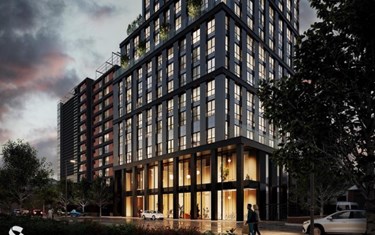Vicky Payne, Urban Design Network Chair, and Colin Bannon, Urban Design Network Co-Chair, reflect on this year’s conference.
 This year’s Urban Design Network Conference focussed on Design Solutions to the Housing Crisis. The half-day online event was a great success and featured four varied presentations looking at this topic from different perspectives and backgrounds.
This year’s Urban Design Network Conference focussed on Design Solutions to the Housing Crisis. The half-day online event was a great success and featured four varied presentations looking at this topic from different perspectives and backgrounds.
Vicky Payne opened the conference by reflecting on the time of year (heading into winter) and the challenging context that everyone is working in. She acknowledged that everyone might be feeling tired and that can be a hard place from which to take on new information or hear about good work. She expressed a desire to take the pressure off, to not promise that the conference would be revolutionary, but might instead provide an opportunity to take a break from the intensity of day-to-day work, learn something useful, or make a new connection, however small.
She explained that the conference chose to focus on the housing crisis because it is a huge challenge facing the UK. One in which planning and urban design have an instrumental role to play. She highlighted that Councils spent £1.7 billion on temporary accommodation for homeless households between April 2022 and March 2023, a 9% increase in spending in just one year (Shelter) and that compared to the average European country, Britain has a backlog of 4.3 million homes that are missing from the national housing market (Centre for Cities). She also acknowledged that it is not just about numbers; we want housing in the right place and with the right infrastructure, housing that is sustainable, well designed and built to last.
She emphasised that there is not one, neat simple solution to addressing the problem and that each of the attendees works in different geographic, political and economic contexts that will need their own unique solutions. She expressed hope that attendees would find something useful in the mix of speakers.
Building on Britain’s Road Belt
David Milner began by highlighting the interconnectedness between transport and urban design and the need to move towards vision and people-led placemaking. David explained how predict and provide models are failing at present in terms of infrastructure-led road making, with infrastructure costs predominantly channelled towards reducing travel time rather than other considerations such as design or reducing noise. Through various national and international examples, David showcased opportunities to increase place-making and land-value capture. The crucial need to improve light rail within the UK was also discussed.
Opportunities for new settlements
Katy Lock presented new settlements as part of a portfolio of solutions to the housing crisis. Katy referenced Garden City Principles as a framework for good sustainable placemaking and opportunities for long-term stewardship in new settlements. There is a key need for a strategic national spatial approach in this respect alongside opportunities for enhanced community development and public participation.
Urban densification
Jas Bhalla then explored urban densification through his work in Essex, which focussed on identifying ways to improve walkability. Jas noted how conventional sub-urban housing models can be significantly improved to enhance land optimisation, for example in terms of the amount of space given over to the storage and servicing of cars. Examples such as Goldsmith Street in Norwich demonstrate how sites can work harder in terms of re-imaging density and internal layout, with cars and parking accommodated in a different way.
Retrofit at Scale
Finally, Helene Gosden focussed on Retrofit at Scale within the context of the 28 million homes in the UK in need of retrofitting to meet 2050 commitments, with an estimated cost of £500 billion over the next 20 years. Despite these daunting figures, there are interconnected benefits and opportunities to retrofitting, with Helene referencing Arup’s holistic vision for impact across the value chain and their blended finance model which sits behind the retrofit programme. To propel this initiative there is a clear need for a national retrofit strategy and general guidance that can be shaped to suit a particular locality so the process of retrofitting can then be streamlined to provide confidence to applicants.
The event concluded with an audience Q&A, during which attendees had an opportunity to reflect on what they had heard. Among the points raised were the need to remember that some people still need to use private vehicles, whether due to their work or accessibility requirements; that the mid-density housing that creates good urban design can make addressing parking requirements challenging; that some people want lower density suburban housing; and that financial factors like delivery models can have a huge impact on overall quality of development.
The presentation slides from the event can be downloaded here.
The UDN is open to all RTPI members and consists of over 1000 individuals. Members can register via the online joining form.


